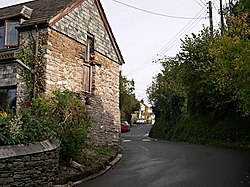St John, Cornwall: Difference between revisions
Created page with "{{Infobox town |name=St John |county=Cornwall |picture=St John - geograph.org.uk - 372943.jpg |picture caption= |os grid ref=SX409536 |latitude=50.361 |longitude=-4.238 |popul..." |
|||
| Line 19: | Line 19: | ||
==Geography== | ==Geography== | ||
[[File:St John Church - geograph.org.uk - 372955.jpg|left|thumb|200px|St John Church]] | [[File:St John Church - geograph.org.uk - 372955.jpg|left|thumb|200px|St John Church]] | ||
The parish is opposite [[Plymouth]], separated from it by St John's Lake, an inlet of [[Hamoaze|The Hamoaze]] in [[Plymouth Sound]]. The parish population at the 2011 census was just 391 | The parish is opposite [[Plymouth]], separated from it by St John's Lake, an inlet of [[Hamoaze|The Hamoaze]] in [[Plymouth Sound]]. The parish population at the 2011 census was just 391. | ||
To the north, St John parish is bordered by St John's Lake and to the south by the sea. To the east, the parish is bordered by [[Millbrook, Cornwall|Millbrook]], to the south-east by [[Maker-with-Rame]] and to the west by [[Antony]] | To the north, St John parish is bordered by St John's Lake and to the south by the sea. To the east, the civil parish is bordered by [[Millbrook, Cornwall|Millbrook]], to the south-east by [[Maker-with-Rame]] and to the west by [[Antony]]. | ||
A few hundred yards north of St John village is an area of high ground called Vanderbands, the site of an Iron Age castle mentioned by John Norden (an early topographer who wrote a series of county histories) in his description of Cornwall published in 1728.<ref>''John Norden's Manuscript Maps of Cornwall and its Nine Hundreds'', Ravenhill, University of Exeter, 1972</ref> | A few hundred yards north of St John village is an area of high ground called Vanderbands, the site of an Iron Age castle mentioned by John Norden (an early topographer who wrote a series of county histories) in his description of Cornwall published in 1728.<ref>''John Norden's Manuscript Maps of Cornwall and its Nine Hundreds'', Ravenhill, University of Exeter, 1972</ref> | ||
The 'St John's Lake Site of Special Scientific Interest' is designated mainly for its bird interests, with | The 'St John's Lake Site of Special Scientific Interest' is designated mainly for its bird interests, with 6,000 wildfowl and 10,000 waders owerwintering on the mudflats.<ref>{{sssi|1000512|St John’s Lake}}</ref> | ||
There is an unusual tidal ford here, on a minor public road. | There is an unusual tidal ford here, on a minor public road. | ||
Latest revision as of 15:20, 1 October 2016
| St John | |
| Cornwall | |
|---|---|

| |
| Location | |
| Grid reference: | SX409536 |
| Location: | 50°21’40"N, 4°14’17"W |
| Data | |
| Population: | 391 (2011) |
| Post town: | Torpoint |
| Postcode: | PL11 |
| Dialling code: | 01752 |
| Local Government | |
| Council: | Cornwall |
| Parliamentary constituency: |
South East Cornwall |
St John is a coastal village in south-eastern Cornwall, three miles south of Saltash and a mile and a half south-east of Torpoint.
Geography

The parish is opposite Plymouth, separated from it by St John's Lake, an inlet of The Hamoaze in Plymouth Sound. The parish population at the 2011 census was just 391.
To the north, St John parish is bordered by St John's Lake and to the south by the sea. To the east, the civil parish is bordered by Millbrook, to the south-east by Maker-with-Rame and to the west by Antony.
A few hundred yards north of St John village is an area of high ground called Vanderbands, the site of an Iron Age castle mentioned by John Norden (an early topographer who wrote a series of county histories) in his description of Cornwall published in 1728.[1]
The 'St John's Lake Site of Special Scientific Interest' is designated mainly for its bird interests, with 6,000 wildfowl and 10,000 waders owerwintering on the mudflats.[2]
There is an unusual tidal ford here, on a minor public road.
Parish church
The historic records for much of this area were kept at Mount Edgcumbe House but were destroyed during the war. We do know, however, that a church existed here in 1080.
The present church was built in about 1150. It was originally dedicated to St John the Evangelist but was later, probably in about 1490, changed to St John the Baptist. It stands in St John village.[3]
The church was a Norman foundation but only the low western tower survives from the Norman period. The chancel and nave were rebuilt in the 15th century and subsequently restored.[4]
References
| ("Wikimedia Commons" has material about St John, Cornwall) |
- ↑ John Norden's Manuscript Maps of Cornwall and its Nine Hundreds, Ravenhill, University of Exeter, 1972
- ↑ SSSI listing and designation for St John’s Lake
- ↑ Cornish Parish Churches website
- ↑ Cornish Church Guide (1925) Truro: Blackford; p. 113
